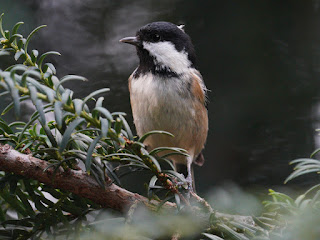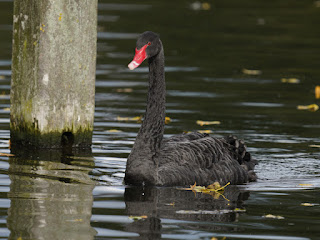A Robin the the Dell objected strongly to something I couldn't see, probably a Magpie.
A Long-Tailed Tit stared gravely from a twig.
The Coal Tit in the Flower Walk came down to take several pine nuts from my hand.
The Great Spotted Woodpecker near the bridge appeared again.
How hard it is to photograph a Magpie in sunshine. You have to underexpose considerably, and then lighten the picture till the white starts to flare, but the black remains obstinately dark.
The first Common Gull to return for the winter has been here for three days but no others have arrived yet.
Undeterred by being thrown out by the resident Mute Swan yesterday, the Black Swan was back on the Long Water. I think the same thing happened again, because I saw it returning hastily to the Serpentine. But Black Swans enjoy pushing their luck.
The female Wigeon is still on the Long Water, and was asleep on the gravel strip ...
... with two Gadwalls, a Tufted Duck, a Mallard and two Shovellers.
Shoveller drakes are also very hard to photograph in sunshine.
These are the blondest Egyptian Geese I've ever seen, newly arrived in the park. Our resident palest Egyptian, Blondie, has ash-grey primaries -- and so did the late Mrs Hopeless, who died this year at the age of at least 22 -- but the primaries on these geese are almost white. The normal Egyptian in the background has dark grey-brown, almost black, primaries.
The durable pink Rugosa rose in the Rose Garden is still putting out flowers. This one was visited by ...
... a tiny metallic green midge.
In the Italian Garden, a dance to autumn in the spirit of Jules Feiffer.
She was filming herself with this camera. A Mute Swan was interested, but decided it wasn't edible and went away.











The Coal Tit is looking very alert- no doubt for its food.
ReplyDeleteRosa rugosa looks stunning & the hips are fine too. Greenfinches are quite partial to them. Though a fine garden plant it can be an invasive plant in sand dune habitats. Remember being at Dawlish Warren NNR some years back where there was lots of this & English Nature where spraying some of it.
I think your green midge on it is one of the tiny hoverflies, though from the photo I wouldn't attempt at a proper ID.
Thanks for the information about the hoverfly. I couldn't get a good top view of it, as explained in the following blog post (for Friday 15 October) where I have put another picture of the insect, still a side view but perhaps more identifiable.
DeleteHad it been a gull and not a swan God knows what would have happened to the camera:
ReplyDeletehttps://www.youtube.com/watch?v=rIu5B3Fsstg
Magpies are so pretty, they have the right to be a little difficult.
Sad to hear about Mrs Hopeless's passing. Perhaps Mr Hopeless can acquire now a sensible mate.
That's a wonderful video. Lucky the camera stayed right side up at the crucial moments. The gull's contralto voice and a brief flash of it shows it to be a Lesser Black-Back.
DeleteMr Hopeless has disappeared too, or at any rate I don't know where he is. He is or was absolutely normal in appearance, and it seems from watching the pair that Egyptians show no outward signs of old age until they become completely decrepit.